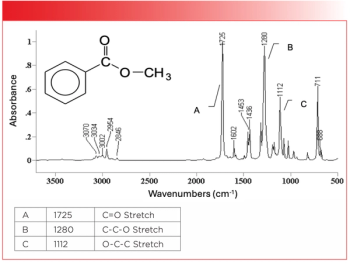
New Infrared Spectroscopy Technique Enhances Mars-Analogue Basalt Sample Analysis
Scientists demonstrate submicron detection of microbes and minerals in Mars-analogue basalt using O-PTIR spectroscopy
A team of international researchers has successfully applied a new infrared spectroscopy technique to detect microbes and smectite minerals at submicron scales in Mars-analogue basalt samples. The findings, published in the International Journal of Astrobiology, highlight the potential of optical-photothermal infrared (O-PTIR) spectroscopy in planetary science, particularly for future Mars sample return (MSR) missions (1).
An Innovation in Mars Sample Analysis
As space agencies prepare for the MSR mission, the detection of potential biosignatures in Martian rock samples is a top priority. A working group organized by the Committee on Space Research (COSPAR) developed the Sample Safety Assessment Framework (SSAF), which outlines high-sensitivity analytical methods for studying Martian samples under strict containment. This study, led by Yohey Suzuki from the University of Tokyo and an international team, tests the capability of O-PTIR spectroscopy, a relatively new technique, in comparison to traditional Fourier-transform infrared (FT-IR) microscopy (1,2).
The Challenge of Detecting Life in Martian Rocks
Previous research indicated that microbial colonization occurs in clay-filled fractures of basaltic rocks. Traditional spectroscopic techniques such as nanoscale secondary ion mass spectrometry (NanoSIMS) and transmission electron microscopy (TEM) identified organic material but required destructive sample preparation. FT-IR microscopy, a non-destructive method listed in the SSAF, is limited by a spatial resolution of 10 microns, making single-cell microbial detection challenging (1,2).
O-PTIR spectroscopy, however, offers a spatial resolution of 0.5 microns, allowing for more precise in-situ analysis without extensive sample preparation. This advancement is crucial for studying Martian samples, where every grain of material is precious (1).
Key Findings: Microbial and Smectite Detection at the Submicron Scale
The researchers applied O-PTIR spectroscopy to a 100-micron-thick section of a Mars-analogue basalt core, originally obtained from a deep-sea drilling expedition. The analysis successfully detected microbial cells within the clay-filled fractures, producing spectra consistent with previous NanoSIMS findings. Additionally, O-PTIR identified the iron-rich smectite mineral nontronite, a key component in Martian rock formations (1).
Compared to conventional FT-IR microscopy, which struggled to analyze thicker samples without significant signal loss, O-PTIR provided clear, diagnostic spectra of microbial biomolecules and smectite minerals. The study confirmed that O-PTIR outperforms deep ultraviolet (DUV) fluorescence microscopy and micro-Raman spectroscopy, particularly in detecting smectite minerals and distinguishing biological material from abiotic backgrounds (1).
Implications for Mars Sample Return and Planetary Science
The ability to detect both microbes and smectite at the submicron scale is critical for future Mars sample analyses. Smectites are known to preserve organic biosignatures, making them prime targets for detecting potential signs of life. By integrating O-PTIR into the suite of analytical techniques for MSR, scientists can maximize data collection while preserving sample integrity.
The research was a collaboration between institutions including the University of Tokyo, Goethe University Frankfurt, Rutgers University, NASA Goddard Space Flight Center, NASA Johnson Space Center, Imperial College London, and others. The team’s findings reinforce the importance of using high-resolution, non-destructive spectroscopic techniques for planetary exploration (1,2).
Future Applications and Next Steps
While O-PTIR has shown remarkable capabilities, it is not a standalone solution. Researchers suggest combining O-PTIR with mass spectrometry and next-generation sequencing for a comprehensive analysis of Martian samples. If Martian lifeforms differ significantly from Earth-based biology, O-PTIR may help identify complex organic molecules unexplained by known abiotic processes (1).
The study underscores the need for further validation using Mars-analogue materials. As NASA and international partners finalize protocols for handling returned Martian samples, O-PTIR spectroscopy could play a crucial role in unraveling the secrets of the Red Planet’s geological and possibly biological history (1).
References
(1) Suzuki, Y.; Koduka, M.; Brenker, F. E.; Brooks, T.; Glamoclija, M.; Graham, H. V.; Kieft, T. L.; McCubbin, F. M.; Sephton, M. A.; Van Zuilen, M. A. Submicron-Scale Detection of Microbes and Smectite from the Interior of a Mars-Analogue Basalt Sample by Optical-Photothermal Infrared Spectroscopy. Int. J. Astrobiol. 2025, 24, e1. DOI:
(2) Dong, M.; Yang, W.; Hao, J.; Jia, X.; Yang, O.; Lo, M. K.; Cao, B.; Hu, S.; Lin, Y. Cross-Scale Multimodal Imaging for Organic Matter in Extraterrestrial Samples. Anal. Chem. 2025. DOI:
Newsletter
Get essential updates on the latest spectroscopy technologies, regulatory standards, and best practices—subscribe today to Spectroscopy.




